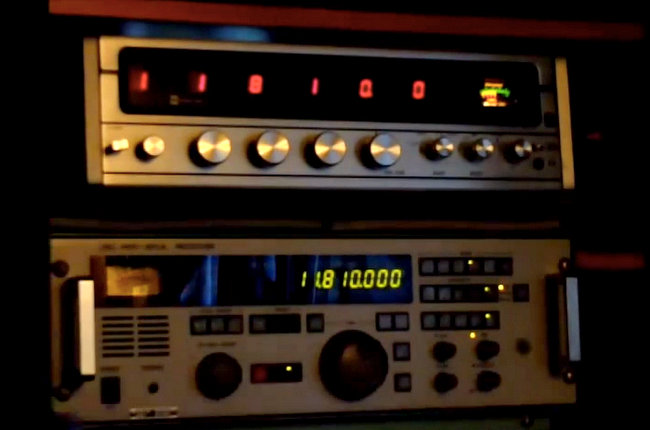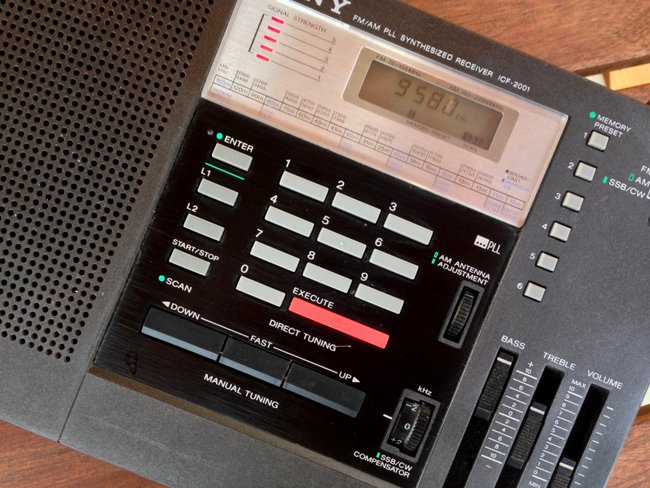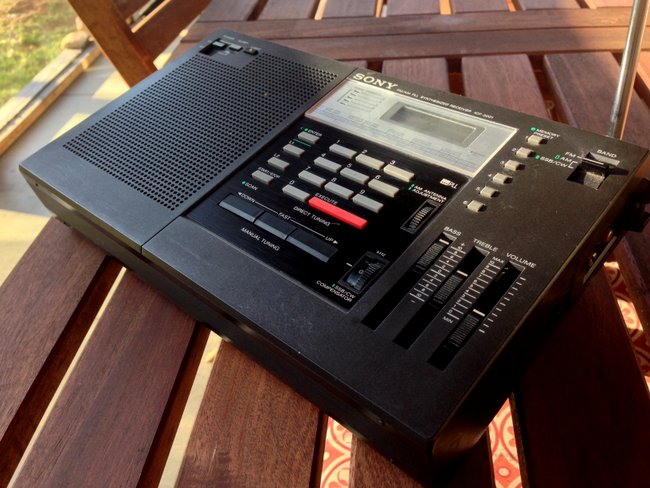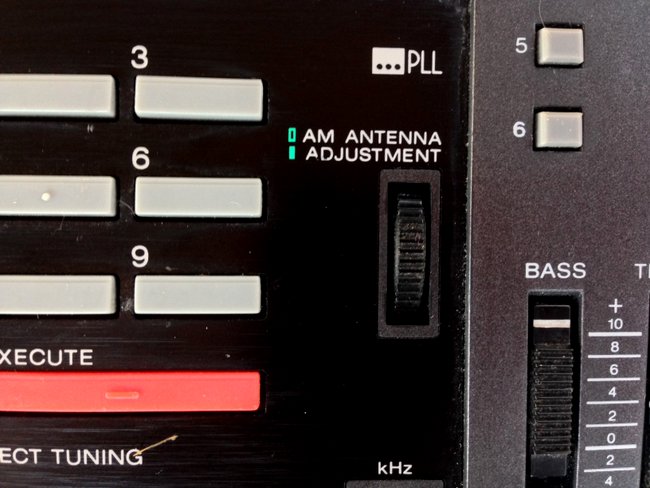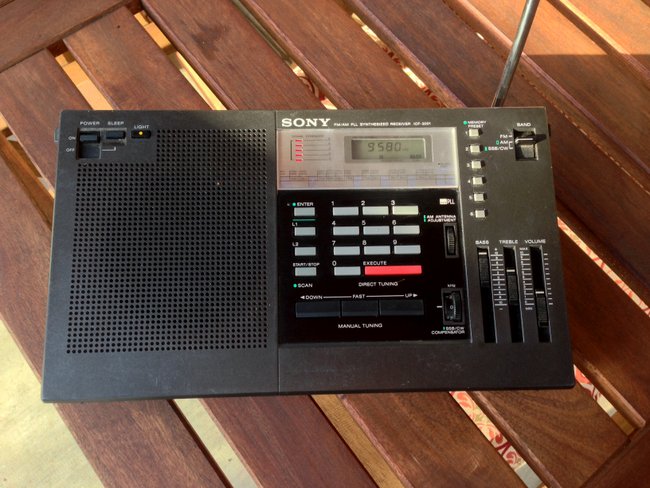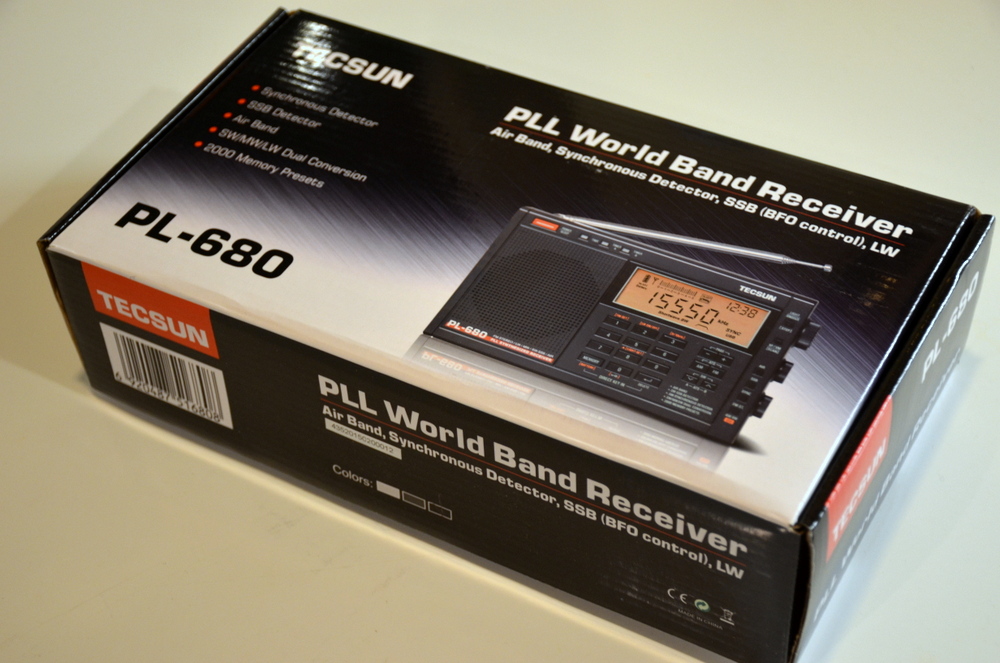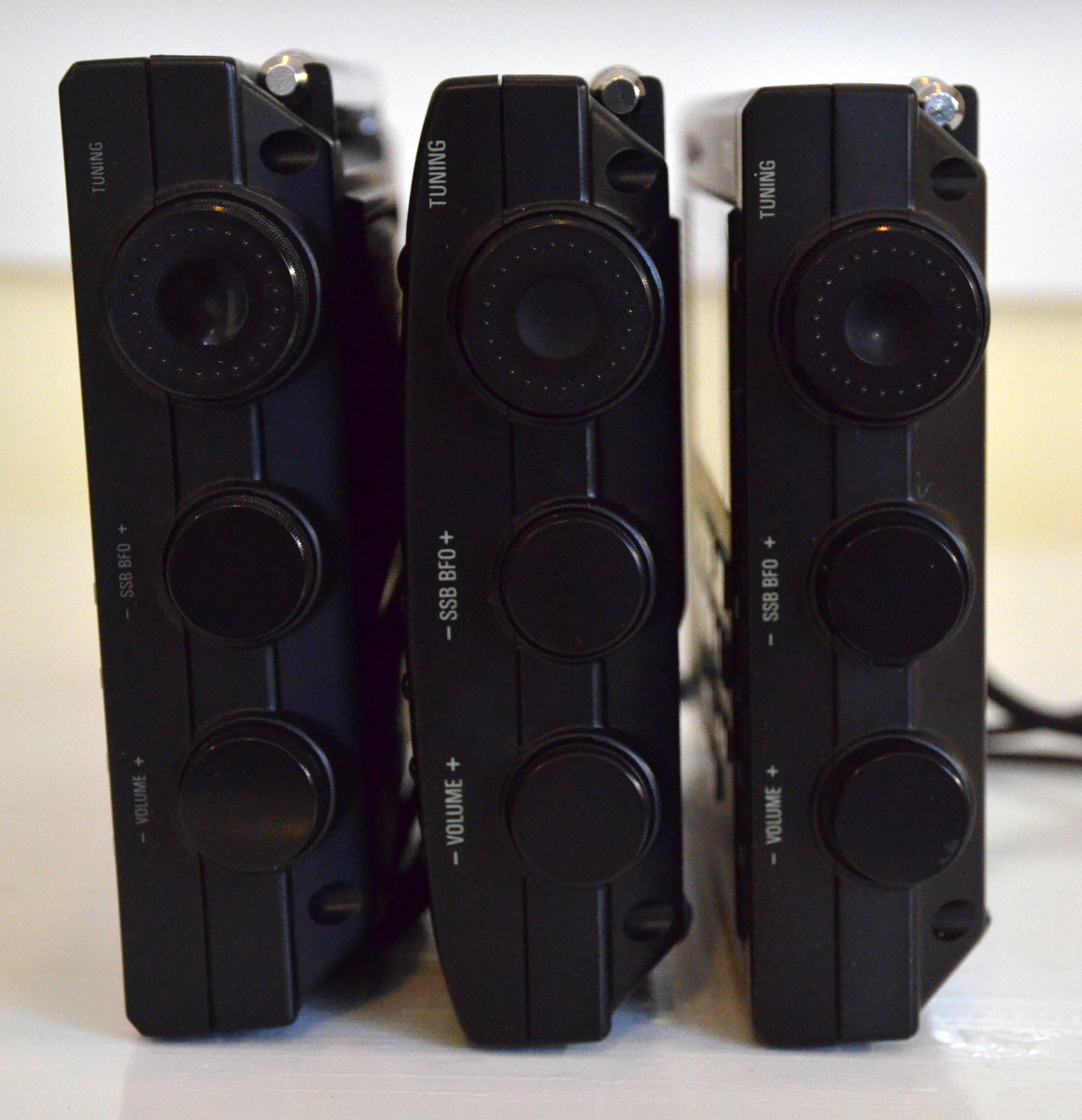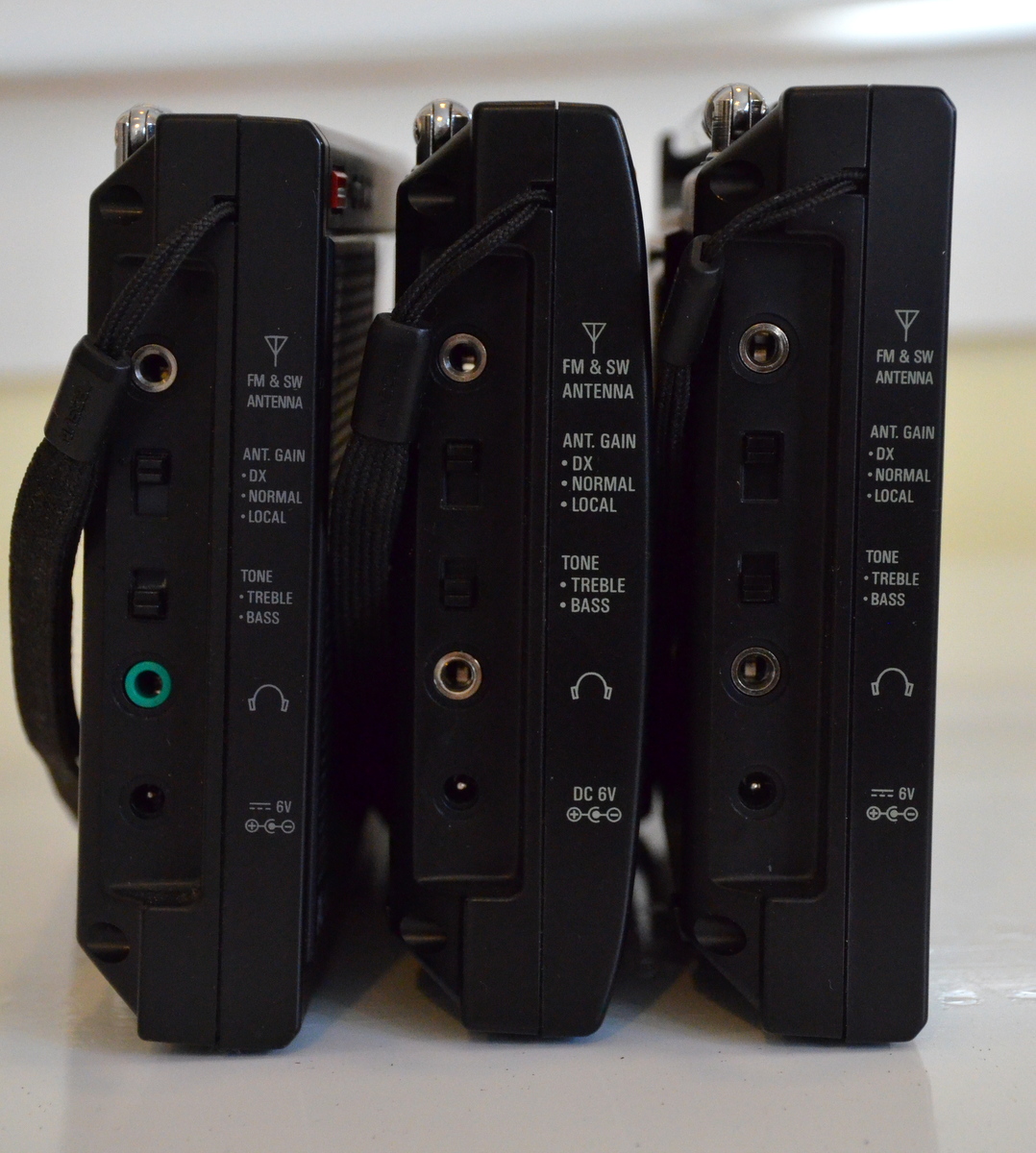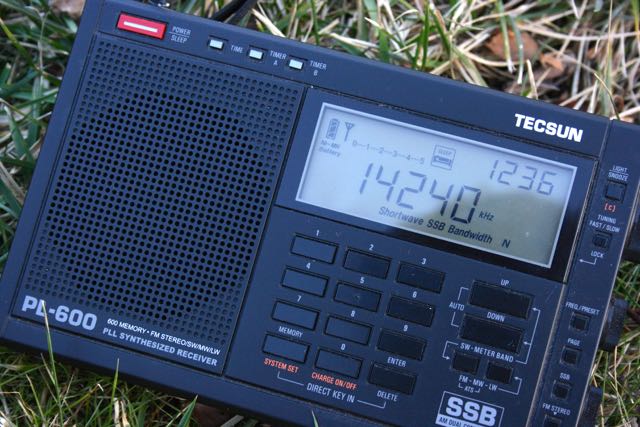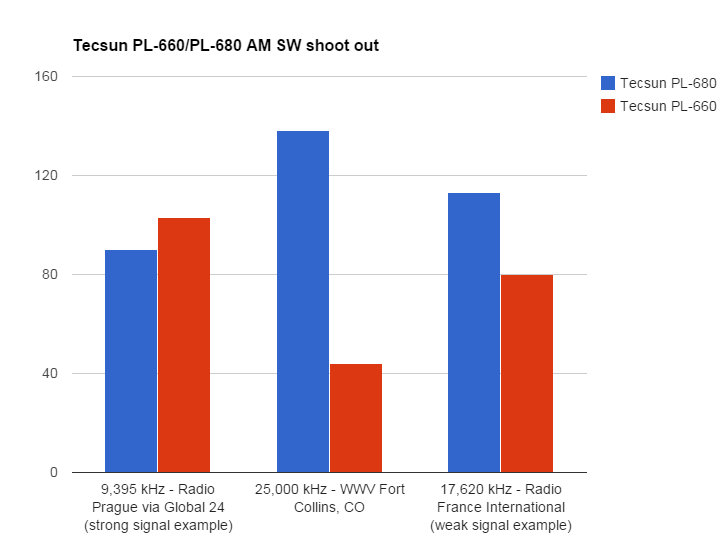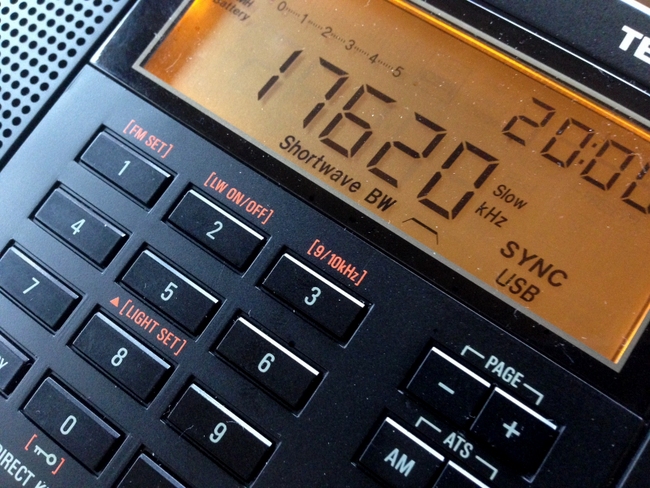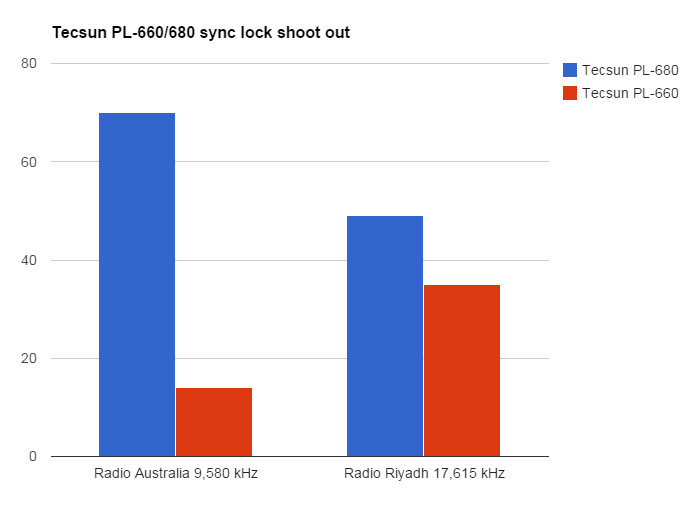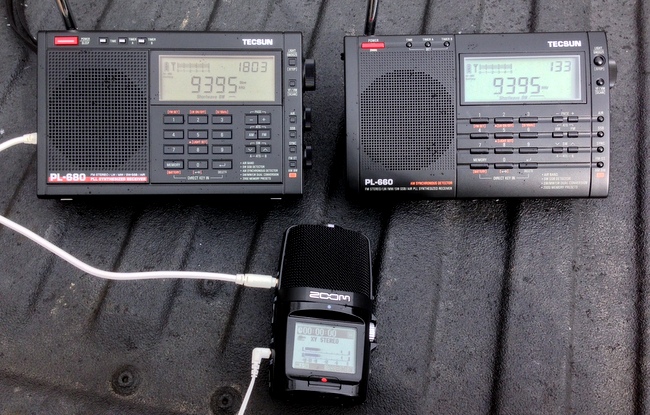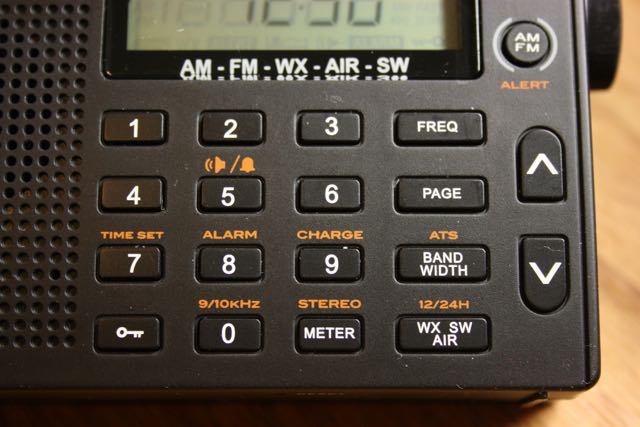Many thanks to SWLing Post contributor, Dan Robinson, who shares this YouTube video comparing four of his receivers: the McKay Dymek DR33-C6, the East German made RFT EKD 515, Japan Radio Company NRD-301A, and his Watkins Johnson 8718A/MFPWJ WJ .
Category Archives: Shortwave Radio Reviews
My new (to me) Sony ICF-2001 shortwave radio
A few weeks ago, I made an impulse purchase: a Sony ICF-2001.
Perhaps it was the post about John Lennon’s ICF-2001, or perhaps it was the simple fact I couldn’t afford a ‘2001 when I was a kid; either way, I saw what I thought was a fair price and I bit the bullet.
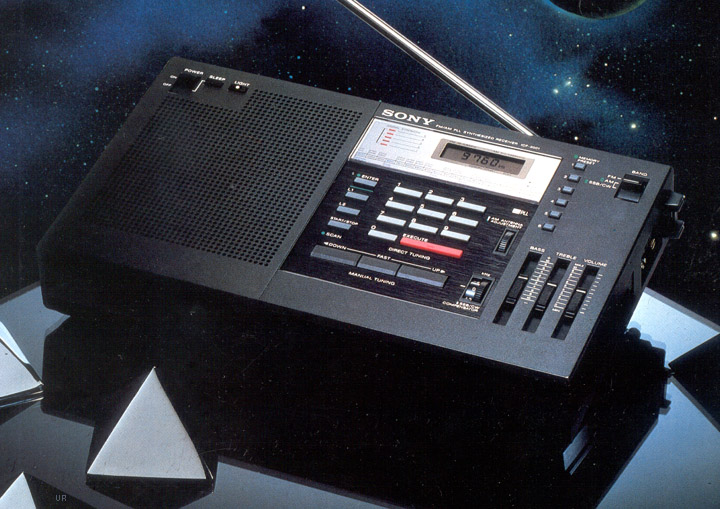 At about 9-10 years old I remember seeing the (above) image of the ICF-2001 in an advertisement and imagining all that I could hear with this amazing–microprocessor-controlled, dual conversion, frequency synthesized general coverage(!)–portable receiver.
At about 9-10 years old I remember seeing the (above) image of the ICF-2001 in an advertisement and imagining all that I could hear with this amazing–microprocessor-controlled, dual conversion, frequency synthesized general coverage(!)–portable receiver.
At the time, my only shortwave radio was the Zenith Trans Oceanic Royal D7000–a wonderful radio for sure–but the convenience of digital tuning? I could only imagine.
The ICF-2001 had revolutionary featured like direct access keypad tuning and an LCD digital readout. The ICF-2001 covered 150 to 29,999 kHz and, like my Transoceanic, could receive single sideband. It also had six memories that could be assigned to buttons for quick access to my favorite frequencies. Six. Whole. Memories!
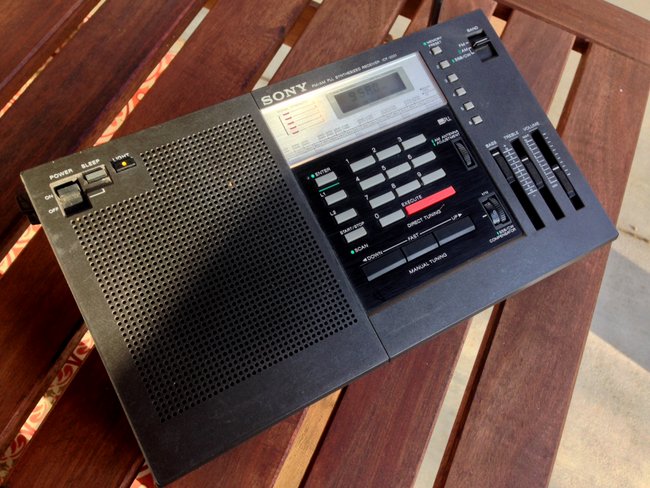
I picked up my used ICF-2001 for $67.00 US shipped. The seller (a fellow ham radio operator) insured that the radio was in excellent mechanical shape, though cosmetically showed some signs of wear. The only thing missing was the ICF-2001’s shoulder strap. That was fine by me, though, because the seller included all original manuals/documentation and a very cool canvas carry bag (below) that fits the ICF-2001 like a glove.
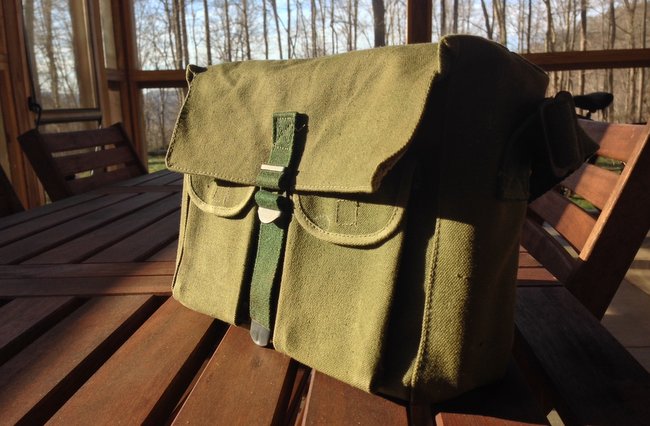 I’ve had the ICF-2001 for a few weeks now and I must say that I’m quite pleased. It’s much larger that most portables currently on the market, but was probably slightly smaller than the venerable ICF-2010.
I’ve had the ICF-2001 for a few weeks now and I must say that I’m quite pleased. It’s much larger that most portables currently on the market, but was probably slightly smaller than the venerable ICF-2010.
The audio from the ICF-2001’s built-in speaker is top-notch; with separate treble and bass control, it’s easy to adjust audio to your taste.
Would the ICF-2001 out-perform a modern portable receiver? Probably not. Was performance similar to the ICF-2010? No way. The ICF-2001 has a few annoying quirks (like muting between frequencies, no tuning knob, a backlit display that’s rather small and hard to read at certain angles)–items most modern portables have long since addressed.
With that said, the ICF-2001 does have a few features I wish modern receivers would adopt, like, a built-in antenna trimmer.
This morning, on my porch, I listened to several broadcasters across the bands and used the antenna adjustment to tweak the match. The adjustment would sometimes increase reception by three S units. I would love to have a similar feature on, say, my Tecsun PL-680.
I also like the old school power switch–a proper mechanical switch that makes it much more difficult to accidentally turn the radio on while traveling or operating in a portable setting.
Even thought the ICF-2001 was a bit of an impulse purchase, I have no buyer’s remorse at all. She’s a sturdy rig with great audio and, I believe, decent performance on the shortwave and medium wave bands. I can certainly confirm that it would have blown my mind when I was 9 years old!
Besides..if the ICF-2001 is good enough for John Lennon, it’s good enough for me!
Any SWLing Post readers out there still have a Sony ICF-2001?
A review of the Tecsun PL-680 with reader survey results
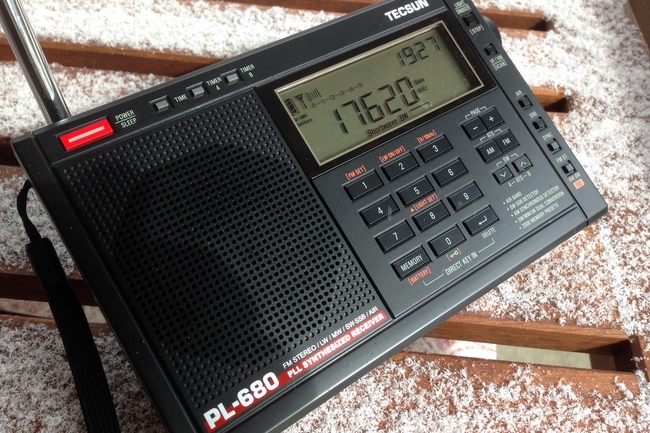 When I heard early reports about the new Tecsun PL-680, I was already wondering how it would stack up alongside other Tecsun portables. An early photo of the Tecsun PL-680 revealed how very similar it is, indeed, to the Tecsun PL-600, which has been on the market for many years. Moreover, the features of PL-680, which I heard about only a few weeks ago, sounded to me like a carbon copy of the venerable PL-660. I investigated further, and spoke with Anna at Anon-Co; she was given to understand that the Tecsun PL-680 was essentially a re-packaged PL-660 with improved sensitivity. I was curious enough about the PL-680 that I ordered one from Anna as soon as they were available, even paying for expedited shipping in order to have it in hand a bit sooner.
When I heard early reports about the new Tecsun PL-680, I was already wondering how it would stack up alongside other Tecsun portables. An early photo of the Tecsun PL-680 revealed how very similar it is, indeed, to the Tecsun PL-600, which has been on the market for many years. Moreover, the features of PL-680, which I heard about only a few weeks ago, sounded to me like a carbon copy of the venerable PL-660. I investigated further, and spoke with Anna at Anon-Co; she was given to understand that the Tecsun PL-680 was essentially a re-packaged PL-660 with improved sensitivity. I was curious enough about the PL-680 that I ordered one from Anna as soon as they were available, even paying for expedited shipping in order to have it in hand a bit sooner.
The Tecsun PL-660 has been on the market for several years now; it’s one of the most popular shortwave portables on the market. And for good reason: the PL-660 is relatively inexpensive, simple to use, packs all of the most vital and desirable functions/modes, and is available from a variety of retailers that ship worldwide. I have reviewed it numerous times and often used it as the basis for comparison with other shortwave portables. It’s China-based manufacturer, Tecsun, has emerged over the past few years as the dominant manufacturer of shortwave radios.
First impressions
I posted a few unboxing photos the day I received the PL-680.
The Tecsun PL-680 looks like the Tecsun PL-600 body, with the Tecsun PL-660 features and layout. Indeed, the full complement of buttons, switches and dials are identically positioned to those of the PL-660.
Let’s cut to the chase…
Question: So, does the PL-680 have more functions than the PL-660?
Answer: No. It appears to be, and likely is, identical in every (functional) respect to the Tecsun PL-660. No surprises here, unless there are hidden features I haven’t discovered…!
Check out the following comparison photos–the PL-600 on the right, PL-660 in the middle, PL-680 on the right (click to enlarge):
The similarity is so striking, in fact, that I believe the PL-680 is the first radio I’ve ever turned on for the first time, only to find I immediately knew every function. I’m so familiar with the PL-660 that I could even use the PL-680 in the dark the first night I used it.
It also helps, of course, that the PL-680 is nearly identical to the PL-600, too, which I’ve owned for many years.
Here’s how I see the PL-680 product development equation:
In truth, I was quite disappointed that Tecsun did not add a line-out jack to the PL-680.
The PL-660, alas, lacks line-out, and though my Tecsun PL-880 has a line-out, its default shortwave volume is simply too high to be used by most digital recorders. I had hoped that the PL-680 might have a proper line-out jack, potentially making it a replacement for my trusty Sony ICF-SW7600GR. Unfortunately, this is not the case.
But other than missing a line-out jack, I really have few complaints. I’ve always been a fan of simple radio design and I believe Tecsun has done a good thing by keeping the user experience so similar in their PL-6XX line of portable shortwave radios. Apparently, a good thing is a good thing.
But here’s what everyone wants to know…
Question: Does the PL-680 have any performance advantages over the PL-660?
Short Answer: Yes! (But keep your PL-660.)
I should add here that I’m about to get rather technical and radio-geeky, so if you’re only interested in a summary, please skip to the bottom of the page.
Otherwise, help yourself to a cup of coffee, and let’s talk radio…
Shortwave performance
Since I spend 95% of my listening time on shortwave, I’ll begin with shortwave performance. Again, we’ll compare the PL-680’s performance with that of the PL-660.
Reader survey results
Having had such great results from radio comparison shoot-outs in the past (check out our shoot-out between top portables and ultra-compact radios), I decided it would make sense to invite our informed readership to evaluate the PL-680’s performance in a series of blind, informal tests. (For information about these surveys, please read through the first of the three surveys.)
Shortwave AM broadcast listening
In most circumstances, you’ll find that the PL-680 has better sensitivity than the PL-660. It’s a marginal improvement, but one I certainly notice on the shortwave bands–and so did the majority of readers who participated in the shortwave AM reception survey.
The survey had recordings from a total of three broadcasters: Radio Prague, WWV, and Radio France International.
The PL-680 was “Radio A,” and the PL-660 was “Radio B.”
The Radio Prague recording was quite strong and was the only broadcast in our survey in which the PL-660 and PL-680 ran neck-and-neck.
In truth, I believe strong signal reception on both these radios is excellent and nearly indistinguishable from each other.
Survey results from the WWV and Radio France International recordings showed a strong preference for the Tecsun PL-680. Again, here are the original recordings:
Based on comments from those who participated, the PL-680 came out ahead of the PL-660 in two respects: better sensitivity, and more stable AGC. In both sets of recordings, the signal was weaker than the Radio Prague recording, and QSB (fading) more pronounced. Herein lies a well-known weakness of the PL-660: soft muting and a sometimes over-active AGC equates to more listening fatigue.
Here is a chart with the full survey results based on 194 listener reports. The number of responses are represented on the vertical axis.
Obviously, the engineers at Tecun addressed the soft muting/AGC problem of the PL-660. In all of my time with the PL-680 on the air, I haven’t noticed any soft muting; the audio has been smooth and the AGC copes with fading much better than the PL-660. No doubt, these two improvements alone make the PL-680 a worthy portable for shortwave radio listening.
There is a downside to the improved sensitivity, however: the PL-680 has a slightly higher noise floor than the PL-660. This is mostly noticeable during weak-signal listening. Though I haven’t compared it yet, I’m willing to bet that the noise floor is comparable to that of the Sony ICF-SW7600GR. Personally, if increased sensitivity and stability means a slightly higher noise floor, I’m okay with that. I find that I listen better when the signal is stable and not fluttering/muting with every QSB trough.
Synchronous detection
The second survey focused on synchronous detection, which is a very useful receiver tool that mitigates adjacent signal interference and improves a signal’s stability. Perhaps it was my good fortune that the same day I tested synchronous detection, fading on even strong stations was pronounced at times. Perfect!
The first recording set was from Radio Australia, a relatively strong signal here in North America. Still, QSB was pronounced–making for an unstable signal–and there was hetrodyne interference in the upper sideband of the broadcast. When I switched the radios into lower sideband sync, halfway through, it effectively mitigated the hetrodyne in all of the recordings.
PL-680 – 1st recording Radio Australia
PL-660 – 1st recording Radio Australia
PL-680 – 2nd recording Radio Australia
PL-660 – 2nd recording Radio Australia
The second set of recordings were of Radio Riyadh–a much weaker station–also affected by QSB:
PL-680 – 1st recording Radio Riyadh (wide band filter)
PL-660 – 1st recording Radio Riyadh (wide band filter)
PL-680 – 2nd recording Radio Riyadh (narrow band filter)
PL-660 – 2nd recording Radio Riyadh (narrow band filter)
While I have always considered the PL-660 to sport one of the stronger sync locks in current production portables, it did truly struggle to maintain a lock in both the Radio Australia and Radio Riyadh recordings. Indeed, I was so surprised by how comparatively feeble the sync lock was on Radio Australia, that I disconnected the PL-660 from the recorder and moved to a different location to verify that something nearby wasn’t causing the sync lock instability. It was not; it was solely due to unstable band conditions.
It came as no surprise that survey respondents took note of the PL-680’s stronger sync lock: the PL-680 beat the PL-660 by a wide margin in both sample recordings. I chart the results, below, from a total of 85 responses:
Very good, PL-680! Someday I’d like to compare the PL-680 with the Sony ICF-SW7600GR, which I’ve always considered to have, among current portables, the strongest sync lock.
Single Sideband
I wasn’t able to provide an audio survey of SSB performance since the PL-680 picked up too much noise from my digital recorder to make for a fair contest.
Meanwhile, I’ve spent time listening to both radios in SSB mode and comparing the models. To my ear, both are very close in SSB performance, but again the PL-680 does have a slight edge on the PL-660 in terms of sensitivity and AGC performance.
SSB audio fidelity is very similar in both radios.
FM Performance
While I haven’t spent more than, let’s say, an hour with the PL-680 on the FM band, I have concluded that it is very sensitive–able to receive all of my benchmark local and regional FM stations.
An informal comparison between thePL-680 and the PL-660 also leads me to believe that they are both excellent FM performers and seemed to compare favorably. I would certainly welcome FM DXers to comment with their own evaluations of the PL-680.
Medium Wave Performance
I’ve also posted a medium-wave listener survey since many of you asked that I provide an evaluation of the medium-wave band.
In short, here is where the PL-680 loses to the PL-660: whereas, on the shortwave bands, the PL-680 is more sensitive, it lacks the same sensitivity on the medium-wave bands.
Though I believe the PL-680 does a marginally better job than the PL-660 of handling the choppy conditions of nighttime MW DX, the PL-660 still pulled voices and music out of the static and made them noticeably more intelligible.
The survey result swung very hard in favor of the PL-660, which has long been one of the more notable medium-wave performers among shortwave portables.
I provided a total of four sample broadcast recordings for comparison. Below, I have embedded one of them–a recording of 940 AM in Macon, Georgia, for your reference.
You can listen to all four recordings in the original survey (again, note that Radio A is the PL-680, B is the PL-660).
Survey results were definitive, with a total of 116 responses:
In all but the strong station sample (750 AM – WBS Atlanta), the PL-660 was preferred by a wide margin.
Summary
Invariably, all radios have strengths and weaknesses; here is a list of my notes from the moment I put the Tecsun PL-680 on the air:
Pros:
- Excellent sensitivity and selectivity on the shortwave bands
- Improved weak signal stability over the PL-660
- Stable sync lock
- Proven PL-600 form factor with good overall ergonomics
- Great internal speaker–an improvement over the PL-660 (but not as good as the PL-880 or Sangean ATS-909X)
- Other than medium-wave performance (see con), a worthy replacement for the PL-660
- Excellent audio from the PL-680 internal speaker (improved over the PL-660, but not matching the fidelity of the PL-880)
Cons:
- Medium-wave performance for is a step backwards from the PL-680’s predecessor, the PL-660. Okay on strong and moderate-signal reception, somewhat poor for weak signals
- Marginal noise floor increase on the shortwave bands
- Like the PL-660, lacks a line-out jack (Please note this, Tecsun!)
- SSB frequency display on my unit is + 1 kHz, slight BFO adjustment is needed (details in this update)
Conclusion
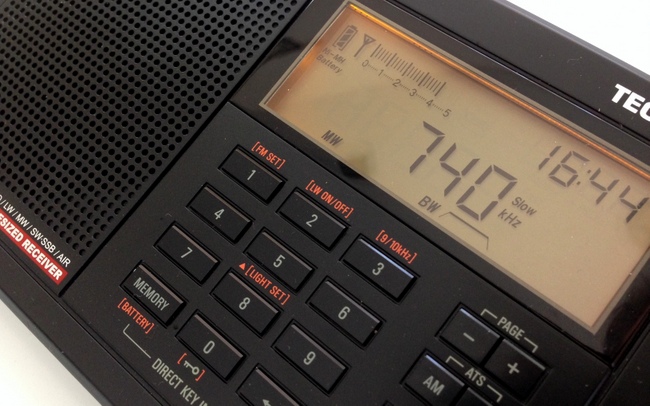 If you’re a shortwave radio listener, you’ll be pleased with the Tecsun PL-680. In all of my comparison tests between the Tecun PL-660 and Tecsun PL-680, the PL-680 tends to edge out the PL-660, performance-wise. This coincides with the user surveys, too.
If you’re a shortwave radio listener, you’ll be pleased with the Tecsun PL-680. In all of my comparison tests between the Tecun PL-660 and Tecsun PL-680, the PL-680 tends to edge out the PL-660, performance-wise. This coincides with the user surveys, too.
If you’re a medium-wave DXer, you might skip over the PL-680. That is, unless Tecsun makes a good iterative design improvement. If you’re a casual medium-wave listener, on the other hand, you’ll probably be pleased with the PL-680.
All in all, I like the Tecsun PL-680 and I see myself using it more than the PL-660 when I’m on the go. If you’re primarily a shortwave radio listener, the PL-680 may very well be worth the upgrade. At $95 US plus shipping, it is certainly a good value. Note that Anon-Co plans to post the Tecsun PL-680 for sale on eBay in March 2015.
Click here to find the PL-680 on eBay.
Addendum:
- PL-680 calibration: Dennis Coomans confirms via Anon-Co that the PL-680 (like the PL-660) can be calibrated by long pressing the AIR button (for SW, AM, etc) and by pressing SYNC for FM. According to Anon-Co, “all PL-680 receivers from production lines after November 2017 have this (hidden) manual calibration feature.”
Reader Survey: Comparing the Tecsun PL-660 and PL-680 on AM shortwave
[Update: Please note that this survey has been closed, but the audio samples–labeled Radio A and Radio B–will remain to allow others the opportunity to make an evaluation prior to reading the PL-680 review.]
[Update 2: The PL-680 review and readers’ survey results have now been posted! Check it out here.]
I’ve been spending a little time with my new Tecsun PL-680 today, and it’s been most interesting. Of course, I’ve already begun to form a few opinions about the radio and am taking notes. Yet I never believe a shortwave radio can be judged in one sitting; there are simply too many variables to account for, such as minute changes in propagation, fading, local radio interference, all of which can have a temporary effect on performance. It’s better to judge a radio after having used it over the course of at least a week or so, in diverse reception conditions.
Still, as I tuned the PL-680, I was already wondering how it compared with its predecessor, the PL-660–? And since I’ve received at least ten emails from readers curious about the same thing, I thought I might start a series of blind audio tests in order to let our readers decide for themselves.
So…ready for some fun?
Below, I’ve embedded eight recordings comparing the PL-660 and PL-680 on shortwave. All of these are recordings of broadcast stations, no SSB yet (I simply didn’t have the time today).
To participate, just listen, then fill out the form that follows with your choice of “Best Radio” for each broadcast. But do note the following:
- I’ve attempted to set the audio levels equally on both radios. Iused the broadcast in the first recording to set the audio levels; they remain at this level for the remainder of the recordings. Nonetheless, you’ll note that one of the radios seems to have lower audio on a couple of the higher-band recordings; this is not due to any change in the incoming volume nor adjustments to the audio levels.
- As seen in the photo above, I used a Zoom H2N digital recorder to make these recordings on the tailgate of my truck. Any time you hook a digital recorder up to a radio on the medium wave or shortwave bands, you most likely will inject a little noise. When I listened to each radio without the recorder in-line, I determined that the Zoom injected very little audible noise.
- The assignment of “Radio A” and “Radio B” was chosen by a coin toss–so pretty much at random!
- I included two recordings of WWV on 25 MHz. This is because the reception conditions from WWV change in a a matter of minutes, which would provide recording variation. I thought it would be best to include two such recordings.
- Both radios have the gain set to “DX” and bandwidth set to wide. None of these recordings employ synchronous detection. The telescopic antenna was fully extended on both units. Additionally, both radios had the tone control set to “bass.”
- No less relevant: it was 32F/OC with strong wind gusts and blowing snow in my face when I made these recordings. But I knew our readers would understand (and likely appreciate) this dedication to the absorbing art of SWLing…just as I appreciate your participation in judging this head-to-head radio showdown!
Audio Samples
9,395 kHz – Radio Prague via Global 24 (strong signal example)
25,000 kHz – WWV Fort Collins, CO
17,620 kHz – Radio France International (weak signal example)
Submit your response
Click here to use our response form to vote on your favorites, or simply use the form embedded below:
Tom Stiles’ Eton Satellit video reviews
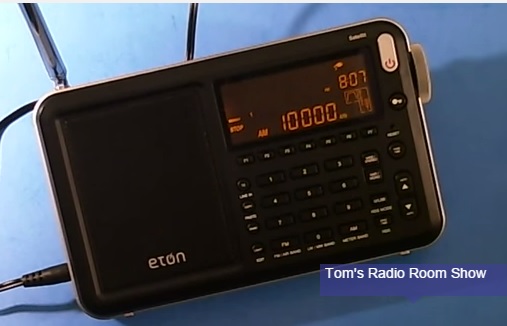 Many thanks to SWLing Post reader, Thomas Ally, who points out that Tom Stiles has published an array of videos featuring the Eton Satellit. The actual reviews and features begin with TRRS #0446.
Many thanks to SWLing Post reader, Thomas Ally, who points out that Tom Stiles has published an array of videos featuring the Eton Satellit. The actual reviews and features begin with TRRS #0446.
Click here to view the complete Eton Satellit video thread on Tom’s Radio Room Show.
Allan’s video review of the CountyComm GP5/SSB
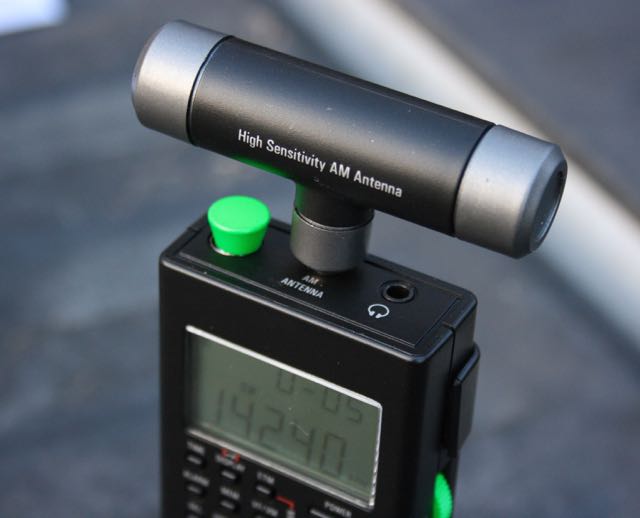 SWLing Post contributor, Dave Zantow (N9EWO), writes:
SWLing Post contributor, Dave Zantow (N9EWO), writes:
Allan’s (W2AEW) excellent “You Tube” Video has just been posted here on the CountyComm GP-5/SSB:
Many thanks for sharing this video, Dave!
Readers: I suggest you check out the library of informative videos Allan (W2AEW) has created over the years and even subscribe to his YouTube channel. His tutorial videos are quite professional and he does a brilliant job explaining complex electronic principles. Indeed, be sure to check out one of his latest on the ETOW HumanaLight kit:
Review of the C. Crane CC Skywave portable radio
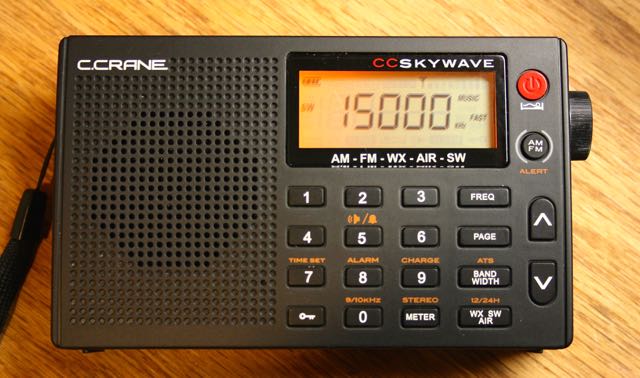 While electronics manufacturer C. Crane offers a number of unique AM/FM radios, including some of the best portable medium wave receivers on the market, they’ve traditionally only had two models of shortwave radio––namely, the CCRadio-SW, and the CCRadio-SWP. Earlier this year, however, C.Crane announced a new portable that would join their product line: the CC Skywave.
While electronics manufacturer C. Crane offers a number of unique AM/FM radios, including some of the best portable medium wave receivers on the market, they’ve traditionally only had two models of shortwave radio––namely, the CCRadio-SW, and the CCRadio-SWP. Earlier this year, however, C.Crane announced a new portable that would join their product line: the CC Skywave.
Admittedly, I was eager to give this little radio a go: C. Crane touts the Skywave as an exceptional travel radio, for which I’m always on the hunt. Last week, I had my opportunity when C. Crane sent me the new CC Skywave sample for review. I instantly got to work scrutinizing their newest offering…and here’s what I’ve discovered.
First impressions
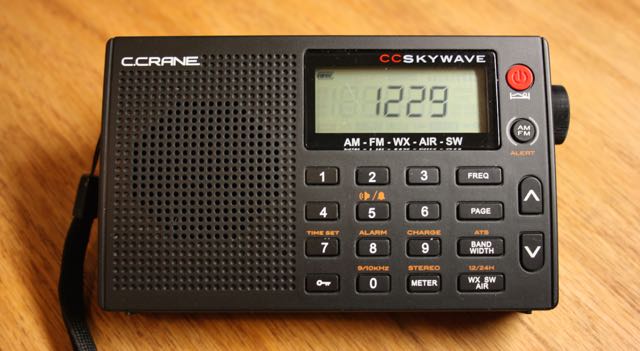 The form factor of the Skywave is very similar to C.Crane’s CCRadio-SWP pocket radio; in fact, its smooth plastic body even feels the same. While this radio doesn’t have the rubberized coating that have become popular on radio exteriors in recent years, supposedly to provide an easy-to-grip surface, I’m pleased that C.Crane does not use this, as these coatings can eventually deteriorate over time and with heat exposure, becoming somewhat tacky or sticky to the touch.
The form factor of the Skywave is very similar to C.Crane’s CCRadio-SWP pocket radio; in fact, its smooth plastic body even feels the same. While this radio doesn’t have the rubberized coating that have become popular on radio exteriors in recent years, supposedly to provide an easy-to-grip surface, I’m pleased that C.Crane does not use this, as these coatings can eventually deteriorate over time and with heat exposure, becoming somewhat tacky or sticky to the touch.
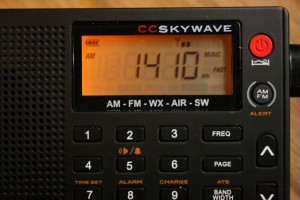 The Skywave’s backlit LCD display is small, but readily viewable from several angles. All of the buttons on the front of the Skywave have a tactile response, again, similar to the CCRadio-SWP. The buttons require slightly more pressure to activate than Tecsun and Degen models; I prefer this, especially for a travel radio: should I forget to activate the key lock, it’s much less likely that the radio will accidentally turn on during transit.
The Skywave’s backlit LCD display is small, but readily viewable from several angles. All of the buttons on the front of the Skywave have a tactile response, again, similar to the CCRadio-SWP. The buttons require slightly more pressure to activate than Tecsun and Degen models; I prefer this, especially for a travel radio: should I forget to activate the key lock, it’s much less likely that the radio will accidentally turn on during transit.
As always, I attempted first to see how many radio features and functions I could uncover without first consulting the owner’s manual. In the past, C.Crane products have been some of the most intuitive on the market. Fortunately, the Skywave did not disappoint: first, I was able to set both the clock and alarm within moments; both essential in a travel radio.
Once the radio is on, it will display either the time or frequency on the main display. While the Skywave defaults to a time display, I discovered that the lock button toggles the display between time and frequency for ten seconds. (Note: After reading through the manual later, I learned that you can actually change the default display mode to either time or frequency–very nice touch!)
I then turned on the radio and found the memory allocation to be very straightforward: tune to the desired station, then press and hold a number button two seconds to save. Press a button quickly to recall. Memory remembers bandwidth, stereo, or mono (if FM), and any voice or music audio filters utilized–very handy!
Speaking of bandwidth, the Skywave has five on shortwave, medium wave, and air bands: 6, 4, 3, 2, and 1 kHz. By pressing the bandwidth button, you can cycle through these from widest to narrowest. The bandwidth defaults to 3 kHz, but the default can be changed by holding down the bandwidth button for five seconds (with radio powered off).
To enter a frequency in AM/FM/SW, you simply press the FREQ button, then key in frequency. To scan through the band, simply press and hold one of the up/down arrow buttons. Worth noting: the Skywave’s scan function is one of the fastest I’ve seen in a portable.
On the topic of scanning, and since this is a travel radio, I would have liked C.Crane to include an ETM function like that found in the Tecsun PL-310ET and PL-380. It’s quite a handy function for auto-populating temporary memories from a simple band scan. I assume this is not an option on the DSP chip powering the Skywave.
Owner’s manual
Once I had my fun trying to discover as many functions on the Skywave without the manual’s aid, I finally opened it and discovered a few more functions.
One feature I’ve already come to love in the Skywave: the ability to change the tuning speed, and thus frequency step-spacing on the tuning knob (option of 5 or 1 kHz steps), just by pressing the knob itself. I much prefer this to using a front-panel tuning step button because it’s so easy to operate in low-light settings (lounging in bed, for example).
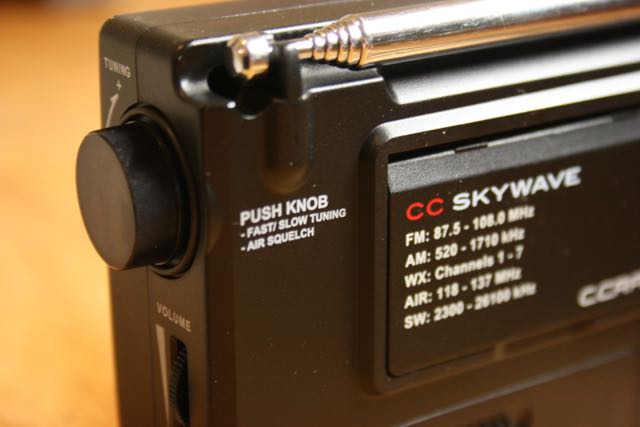 Another unique feature of the Skywave is a switchable audio filter for voice or music. With the filter set to “voice,” the audio is enhanced for human voice intelligibility. When set to “music,” it widens the audio filter, thus optimizing audio fidelity. Toggling the audio filter settings between voice and music is very easy, but not intuitive; indeed, it’s almost a hidden feature you can discover via the owner’s manual. Simply press the “1” and “2” simultaneously while listening to a broadcast to toggle the filter.
Another unique feature of the Skywave is a switchable audio filter for voice or music. With the filter set to “voice,” the audio is enhanced for human voice intelligibility. When set to “music,” it widens the audio filter, thus optimizing audio fidelity. Toggling the audio filter settings between voice and music is very easy, but not intuitive; indeed, it’s almost a hidden feature you can discover via the owner’s manual. Simply press the “1” and “2” simultaneously while listening to a broadcast to toggle the filter.
I should note that the C.Crane owner’s manual is one of the most straightforward and simple I’ve seen in ages. You can tell that, at least in the English version that came with mine, this manual was written by a native English speaker. It made for simple, clear instruction without head-scratching over obscure terms. Even the least technically-inclined user will understand these instructions, no problem.
AM – Medium Wave
After asking SWLing Post readers what they would like me to include in this review, a number of you responded that you wanted me to give the AM broadcast band reception a proper review.
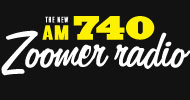 My foray into medium wave listening with the Skywave started off on the right foot. The very first night with the Skywave, I tuned it to 740 kHz, my favorite, albeit challenging to reach, AM station here in the North America–CFZM “Zoomer Radio” While those living in the midwestern and northeastern US can receive Zoomer radio easily enough at night, it is often a tough catch here in the southeast in the evening hours. After nightfall it competes with clear channel stations that also occupy 740 kHz. With a portable radio, the lock on Zoomer is never terribly strong and is very prone to fading.
My foray into medium wave listening with the Skywave started off on the right foot. The very first night with the Skywave, I tuned it to 740 kHz, my favorite, albeit challenging to reach, AM station here in the North America–CFZM “Zoomer Radio” While those living in the midwestern and northeastern US can receive Zoomer radio easily enough at night, it is often a tough catch here in the southeast in the evening hours. After nightfall it competes with clear channel stations that also occupy 740 kHz. With a portable radio, the lock on Zoomer is never terribly strong and is very prone to fading.
But after tuning the Skywave to Zoomer, I received CFZM so well it sounded like a local station–in fact, I couldn’t believe it until a station ID confirmed that I was receiving it. Even more surprising was that I received it away from home, in an area plagued with RFI noise where I typically have to carefully turn a radio to null out the noise in an effort to enhance the desired broadcast. But the Skywave somehow mitigated this noise better than my other portables. Even when I turned the radio in the direction of the offending electrical noise, it wasn’t as bad as on other portables. Truly, the reception was remarkable.
With Zoomer firmly locked in, I hopped into bed, turned the volume to a comfortable level, and listened for at least half an hour before falling asleep. I was pleasantly surprised the following morning, some eight hours later, when I woke to the Skywave playing CFZM at the same level. Phenomenal! Perhaps conditions were exceptionally favorable that night; nonetheless, the Skywave couldn’t have impressed me more.
A side note–on the previous day, I’d inserted two generic alkaline AA batteries in the Skywave; after a total of ten hours playing at medium volume, the battery indicator still showed full capacity.
While time won’t allow a full audio sampling of the medium wave band for comparison, I did record the following comparison between the Skywave and the Tecsun PL-310ET (which I regard as one of the more capable sub-$100 ultra-compact portables on the market).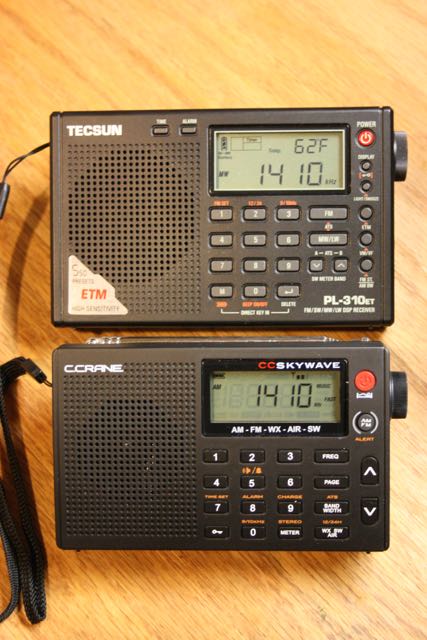
Since SWLing Post readers specifically asked to hear how the Skywave handles choppy nighttime medium wave DX conditions, I tuned to two frequencies with overlapping broadcasts, one of which was slightly dominant: 950 kHz and 990 kHz. I set the AM bandwidth to 3 kHz on both radios and made the recordings within one minute of each other. The CC Skywave’s audio filter was set to “voice.”
In the following recordings, listen for Radio Reloj (Cuba)–it’s buried deep in the noise. You might detect the ticking and “R” “R” in Morse code. These recordings were taken within one minute of each other.
The Tecsun PL-310ET on 950 kHz:
Note that the Skywave pulled out the dominant broadcaster–one I could barely hear on the PL-310ET.
I then made a recording on 990 kHz AM which had a stronger dominant station.
The Tecsun PL-310ET on 990 kHz:
To my ear, the Skywave was clearer and the commentator’s voice seemed to pop out of the noise better.
I’ve spent a great deal of time listening to the Skywave on the medium wave band this week and I feel comfortable recommending it for the medium wave DXer.
FM
While I’ve spent comparatively less time (thus far) evaluating the Skywave’s FM band, I can say that the Skywave receives my “benchmark” FM stations with ease. Sensitivity also seems to be on par with my other DSP based portables (meaning, excellent sensitivity).
Shortwave
Of course, being a shortwave enthusiast, I’ve spent the bulk of my listening time since receiving the Skywave on the shortwave bands. And during this time, alas, shortwave radio band conditions have been challenging for any radio. Yet I’m happy to note that this little radio does not disappoint: it has excellent sensitivity and selectivity for a radio of its size. When I compared the Skywave with the Tecsun PL-310ET, in almost every situation, they are nearly equal in performance.
Shortwave audio samples
Below I’ve included audio samples of the Skywave on 9580 kHz (Radio Australia). Under normal conditions, Radio Australia would be a blowtorch signal here in North America, but this particular morning, propagation was quite poor. In the audio, you’ll hear both radios attempting to cope with pronounced fading, with their AGC circuits reacting to the quick rise and fall of signal strength. Both radios were set to a 3kHz bandwidth and the Skywave’s audio filter set to “voice” to help mitigate noise.
Note that Radio Australia was broadcasting music, which can be more difficult to evaluate, but the vocals were prominent enough I felt it made for a good comparison.
This morning, I also recorded WWV on 15 MHz. Again, propagation conditions were poor across the bands, so even WWV (normally very stable) was affected by quick fading (QSB). For kicks, I decided to add the benchmark Tecsun PL-660 to this comparison. If you recall, it received some of the highest marks for sensitivity in our weak signal shoot out. The Tecsun PL-310ET and CC Skywave were set to 3 kHz bandwidth and the Tecsun PL-660 to it’s narrow bandwidth (which I felt was most equivalent).
The good news is that the Skywave is certainly a sensitive and selective portable. While evaluating shortwave performance over the past week, I’ve been pleasantly surprised by how well this little radio receives.
NOAA Weather radio
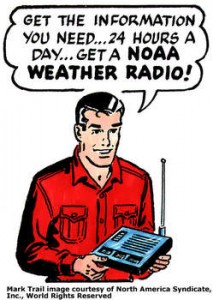 Those of us living or traveling in North America will appreciate the Skywave’s built-in NOAA weather radio functionality. Since I have at least a dozen self-powered radios and desktops that have built-in NOAA weather reception, I typically don’t give the band much thought. I figured NOAA reception would be a mediocre add-on with the Skyview. I was wrong.
Those of us living or traveling in North America will appreciate the Skywave’s built-in NOAA weather radio functionality. Since I have at least a dozen self-powered radios and desktops that have built-in NOAA weather reception, I typically don’t give the band much thought. I figured NOAA reception would be a mediocre add-on with the Skyview. I was wrong.
Not only does the Skywave have NOAA weather radio, but it also has weather alerts. What’s so great about that? Imagine that you’re travelling to a rural area and weather is looking ominous; in this case, you can simply set the Skywave to the strongest NOAA channel and activate the weather alert (choose options for 4, 8, or 16 hours). If severe weather is reported for your geographic area, the Skywave will alert you.
I’m very pleased with the NOAA weather radio reception, as well. The Skywave receives NOAA stations even better than one of my dedicated weather radios.
AIR band
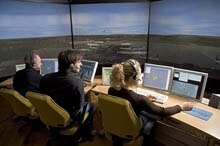 C.Crane included the Air band for travelers, as a means to listen to air traffic control while in an airport or awaiting a flight’s arrival. I have several portables with the AIR band, but most lack an autoscan ability (Grundig G3, G6), and performance on these tends to be mediocre at best.
C.Crane included the Air band for travelers, as a means to listen to air traffic control while in an airport or awaiting a flight’s arrival. I have several portables with the AIR band, but most lack an autoscan ability (Grundig G3, G6), and performance on these tends to be mediocre at best.
I’ve traveled to three different cities over the past week and used the Skywave to tune to the local air-traffic control tower. After a bit of scanning, it eventually found the frequency, and reception was quite good. I have not yet used the AIR band in an airport (notorious for RFI) nor in a large metro area, so I can’t comment about performance under those conditions.
What really separates the Skywave apart from my other shortwave portable with the AIR band is that it actually has an adjustable squelch mode. Nice touch!
CC Buds Earphones
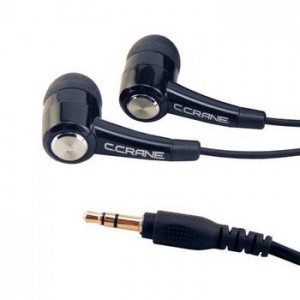 Unlike Tecsun portables which typically ship with batteries, an external antenna wire, chargers, travel cases, and the like, the CC Skywave comes with very few included accessories––just a carry case, an owner’s manual, and earphones.
Unlike Tecsun portables which typically ship with batteries, an external antenna wire, chargers, travel cases, and the like, the CC Skywave comes with very few included accessories––just a carry case, an owner’s manual, and earphones.
Most of the headphones/earphones that accompany a shortwave radio package are of the cheapest quality. I’m happy to note that the Skywave’s included earphones are the best I’ve ever received as an included accessory with a shortwave radio.
The CC Buds Earphones are in-ear style (which I prefer, for sound isolation) with soft silicone earpieces. They are tuned to a frequency response which favors voice, an enhanced mid-range. For SWLing and MW DXing, I believe they’re nearly ideal. Indeed, I’m planning to use these with my Elecraft KX3 next time I’m operating QRP––I’m sure that SSB will sound great.
Since these are tuned for the spoken word, however, I wouldn’t necessarily favor the CC Buds Earphones over my Sony in-ear buds for music listening.
Summary
Every radio has pros and cons, and I jot down my reactions as I evaluate a new radio so as not to forget any details. The following is my list:
Pros:
- Overall great sensitivity and selectivity for a portable in this price class
- Considerate design, well-tailored for the traveler:
- Compact size
- Air band
- NOAA weather radio
- Easy to set clock and alarm
- Simple controls
- Lightweight
- Operates on 2 AA batteries
- Charges from Mini USB (see con)
- Wide HF frequency range (2.3 up to 26.1 MHz) compared to the PL-380/PL-310 (2.3 up to 21.95 MHz)
- AIR band is truly functional: includes both scanning and squelch
- NOAA Weather radio reception excellent
- Includes soft silicone earphones (in-ear type) actually worthy of AM/SW listening
- Auto scanning with the up/down buttons is very rapid
- Integrated charging circuit
- Uses common micro USB port for power/charging
- Tuning speed easily changed by pressing tuning knob
- Volume control is fully variable (free wheel, analog style), not in pre-determined digital steps
- Selectable audio filters for music and voice
Cons:
- Internal speaker audio is somewhat tinny (use of the voice audio filter helps)
- No external antenna jack
- No SSB mode (in this price class of $90 US, SSB is an included mode on some models)
- Only one clock; no provision for dual local/UTC time
- Mutes between frequency changes
- Whip antenna is short––only 16” fully extended. While the Skywave seems to perform brilliantly with this short antenna (see pro), I can’t help but wonder if more length might boost some bands.
- While no inconvenience to me, the Skywave does not come with an adaptor or USB cord for powering/charging. (Should you need it, C.Crane sells a proper noise-free regulated power supply separately ($15 US); however, most buyers will already have these cords and any USB port on your PC or USB-based phone charger will suffice. Also note that listening to virtually any radio while charging will inject noise into the receiver, resulting in sub-par reception.)
- Can overload on shortwave and AIR bands if located near a strong radio station (see this comment)
Conclusion
C. Crane has few shortwave radios in their product line, and all perform rather well for their price point; I know, as I have owned all of them and even purchased as gifts in the past.
But I was concerned a few months ago when I noted the similarity between the CC Skywave and the poorly-reviewed Digitech AR1733, sold in Australia/New Zealand by Jaycar.
Fortunately, it’s clear that C. Crane noticed the shortcomings of the AR1733 and has modified the Skywave’s design and firmware accordingly, which may account for the delayed roll-out of the CC Skywave. Obviously, the Skywave’s ACG circuit has been tweaked to cope with medium wave and shortwave listening, since a poor ACG circuit is one of the shortcomings of the AR1733. But, if so, wow…what a tweak.
Because all in all, the CC Skywave is a excellent little radio. Indeed, in terms of the ultra-compact portable market (models like I included in a recent shoot-out), I think it’s one of the best surprise performers I’ve seen in the past couple of years.
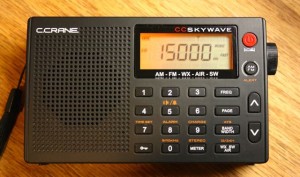 After just one week with it, I’ve already decided to take the CC Skywave along on my travels to see how it performs over time. It will replace my PL-310ET and PL-380 for my one bag domestic and international travelling. The CC Skywave is also especially well-suited for the “go”-bags and “bug-out” bags used in evacuations and other emergencies. Indeed, with AM/FM/SW/AIR plus functional NOAA radio, this little radio packs a lot––in short, the Skywave packs enough to get packed in my bag.
After just one week with it, I’ve already decided to take the CC Skywave along on my travels to see how it performs over time. It will replace my PL-310ET and PL-380 for my one bag domestic and international travelling. The CC Skywave is also especially well-suited for the “go”-bags and “bug-out” bags used in evacuations and other emergencies. Indeed, with AM/FM/SW/AIR plus functional NOAA radio, this little radio packs a lot––in short, the Skywave packs enough to get packed in my bag.
The CC Skywave can be purchased directly from C. Crane. It is also available at (soon) Universal Radio and Amazon.com.

